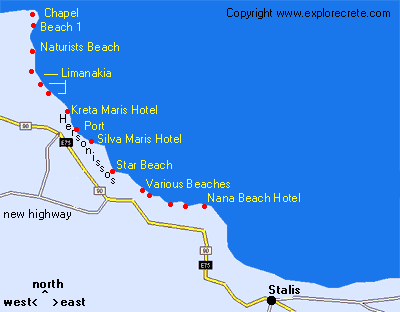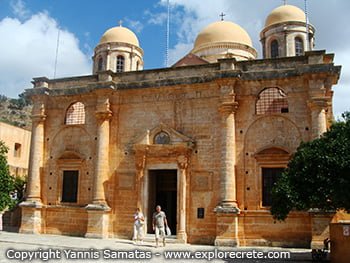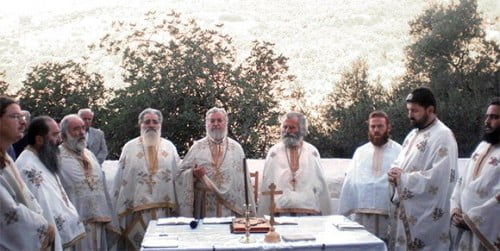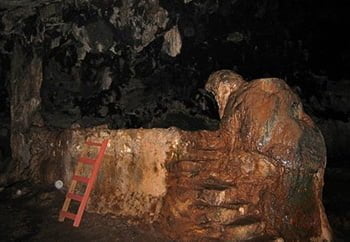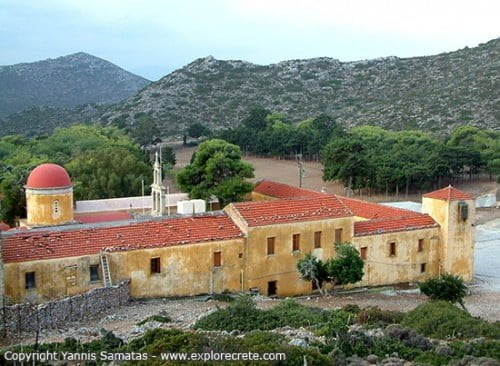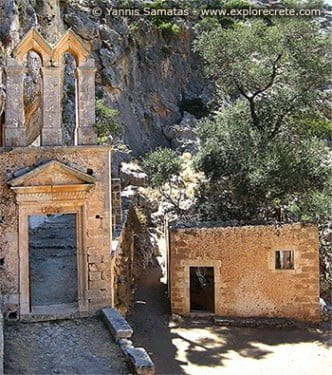Monastery of Koudoumas in South Crete
The Monastery of Koudoumas
Koudoumas, yet another strange Cretan place-name, but one which means a lot to those fortunate enough to have visited this unique place.

Koudoumas, or more properly Koudoumas Monastery (Moni Koudouma in Greek), is located in south Crete, on the south coast of Heraklion Prefecture. It is 2-2.5 hours’ drive from Heraklion, roughly 80 kilometres distant. The last 24 kilometres are along an accessible dirt road which starts at the village of Sternes, climbs Mt Kofinas and then descends from 800-900 metres to Koudoumas Monastery at sea level.
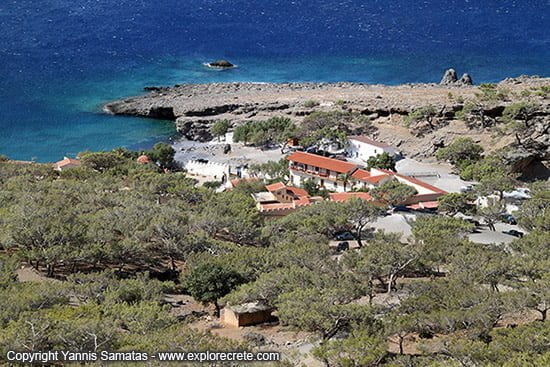
Koudoumas Monastery is dedicated to the Virgin, whose feast-day is celebrated on 15 August, when crowds of people descend on the monastery the previous day and stay overnight in the guestrooms and on the beach.
Another great festival of Koudoumas Monastery is on 10 July, the feast-day of Saints Eumenios and Parthenios, the monks who built the monastery in the 19th century.
How to get to Koudoumas Monastery
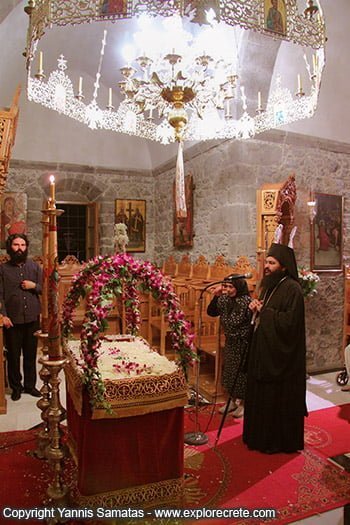
The Abbot prays before the bier of the Virgin on 15 August
If you’re going from Heraklion, take Stelios Kazantzidis Avenue, which starts east of Heraklion Port leading to Peza (exit nο. 3 on the map of Heraklion). After about 10 kilometres turn off the road and take the Archanes exit. Don’t go into Archanes itself but take the road around the town and continue to the village of Charakas.
From Charakas continue to Sternes, approximately an hour’s drive from Heraklion. It is not signposted, but remember to turn right at the war memorial in Charakas.
The dirt road to Koudoumas Monastery starts at Sternes. At first it climbs the slope of Mt Kofinas, through a rough landscape of dust and rocks, a typical image of the desertification that is threatening Crete more and more.
The way is signposted and there is no danger of losing the path. The route is not difficult, but the constant bends make it a tiring drive.
Sternes and Koudoumas Monastery on Google Earth
When you reach the highest point of the road, the peak of Kofinas will be on your right. As soon as you cross the saddle, you will see the vast Libyan Sea spread out before you, the southern sea of Crete on whose opposite shore lies Africa. If you doubt it, turn on the radio and search for stations. The Arab songs you hear are the best proof that you are at the southernmost point of Europe.
From here on, the road winds down in a series of hairpin bends through the pretty pinewood which covers the whole south slope of Kofinas. The dirt road is in good condition and any car can tackle it without difficulty, but at some points it becomes narrower due to rockfalls, so drive slowly and carefully.
About 1.5 hours’ drive from Sternes you come to the “Katarraktis” Gorge and Koudoumas Monastery. Leave your car in the spacious car park outside the monastery, walk through the gate and carry straight on for a dip in the sea.
Koudoumas Monastery is the only seaside monastery in Crete, and the beach with its small pebbles is just the thing to wash off the dust and tiredness.
Koudoumas, an earthly paradise in Crete
You will decide if Koudoumas is truly an earthly paradise in Crete. If you like to spend your holidays in crowds of people, with lots of opportunities for fun and sightseeing, then Koudoumas is not for you.
Koudoumas is for those who want beautiful natural surroundings, peace, free camping, hiking, swimming off beaches with crystal-clear water but no beach umbrellas, people who are not afraid of the relatively tiring drive there, not bothered by the lack of a mobile phone signal, and who do not miss the comforts of civilisation.

Koudoumas is a gentle place when the weather is good, but it can become harsh and unwelcoming when the north wind howls down the cliffs of Kofinas and fills the sea with white “lambs”, as we say in Crete.
Luckily the monastery wall acts as a windbreak and you can carry on swimming peacefully off the beach, even though a few hundred yards further out the wind is whipping up the water into small waterspouts.
On July and August weekends lots of people come down from the nearby villages, but there is room on the beach for everybody.
Apart from weekenders, there are also those who spend their whole summer holidays here, as Koudoumas Monastery is the most welcoming monastery in Crete.
Unusually, Koudoumas Monastery offers accommodation in its many monks’ cells to anyone who wishes it. There is also somewhere to cook, as long as you have remembered to bring food. There is unlimited drinking water, but no food anywhere unless you drive up to Charakas, 30 kilometres away.
What to do at Koudoumas
Swim off the wonderful beach with its small pebbles and clear water.
Camp in the pinewood next to the monastery or on the beach right in front of it. If you’re lucky you may find an empty cave on the beach for shade and coolth.
Fish. You probably won’t catch enough for a decent meal, but you may be lucky and get a good catch for the frying pan.
Relax and discover the joy of life near nature, far from consumer goods and artificial needs. Allow the peace after the noise of the city to clear your mind of stress, trouble and pointless cares.
Enjoy the magic of the night sky in Crete and try to identify the constellations or count the brilliant shooting stars.
Some of you may be interested to know that Koudoumas Monastery houses the icon of the Virgin of Kykkos, which was found in the house of Ali Pasha in Ioannina and donated to the monastery by Eleni Skandalaki in 1957.
The icon of the Virgin Dexiokratoussa (cradling Christ in her right arm) is considered miraculous. It is also known as the Virgin of Kykkos because it is thought to have been painted in the 18th century at Kykkos Monastery in Cyprus.
Walk to Αvvakospilio Cave, an easy half-hour walk to the west. The path begins behind the west cells and follows the shore.
The Avvakospilio is also known locally as Varvakospilio (Falcon’s Cave), but this is folk etymology. It was called Avvakospilio after the many hermits (avvades) who lived there.
If you like hiking, you can take a different, longer path to St Anthony’s Cave. The path starts at the small bridge at the entrance to the monastery. It is 1.5 hours’ walk to the cave with its stalactites and the small chapel inside.
Inside the cave is a small chapel and basins which fill with the water that drips from the stalactites. This is considered holy water.
If you continue past St Anthony’s Cave, you will come to the deserted beach of Elygia and then to the seaside village of Agios Ioannis.
Yet another path runs east to Agios Pavlos and the village of Paranymphi, about 5 hours’ walk away. The path starts on a hairpin bend next to an old stone house, 200 metres before the monastery. It is signposted by a rock blazed with a painted red mark.
I took this path many years ago, but I recently heard that it is now damaged in places. This may make it more difficult for less experienced hikers.
Climb the peak of Kofinas. You can do this more easily by driving up to the little church at the beginning of the path. The peak is just half an hour’s walk away, but the climb is not recommended for those with a fear of heights.
You can also climb Kofinas on foot from Koudoumas Monastery in roughly 3 hours. Some parts of the route are along the old path, while elsewhere you follow the dirt road to the church at the base of the peak.
Take lots of beautiful pictures to impress your friends and make them admire your courage in visiting Koudoumas, that inaccessible landscape, one of the last natural paradises in Crete.
© explorecrete.com All Rights Reserved. Reproduction or copying without permission is prohibited.

